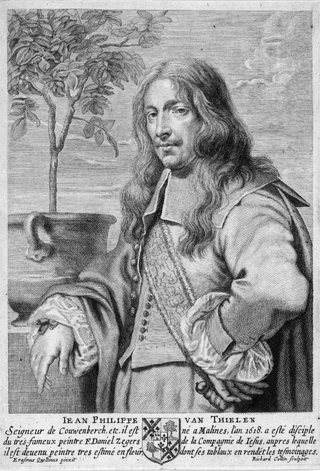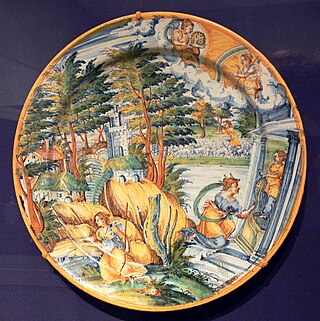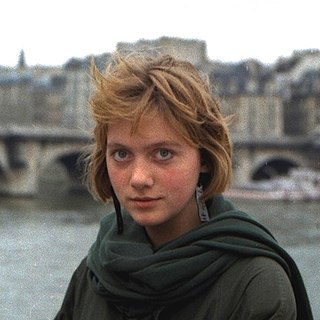
Delft is a city and municipality in the province of South Holland, Netherlands. It is located between Rotterdam, to the southeast, and The Hague, to the northwest. Together with them, it is a part of both the Rotterdam–The Hague metropolitan area and the Randstad.

Delftware or Delft pottery, also known as Delft Blue or as delf, is a general term now used for Dutch tin-glazed earthenware, a form of faience. Most of it is blue and white pottery, and the city of Delft in the Netherlands was the major centre of production, but the term covers wares with other colours, and made elsewhere. It is also used for similar pottery, English delftware.

Maarten van Heemskerck or Marten Jacobsz Heemskerk van Veen was a Dutch portrait and religious painter, who spent most of his career in Haarlem. He was a pupil of Jan van Scorel, and adopted his teacher's Italian-influenced style. He spent the years 1532–36 in Italy. He produced many designs for engravers, and is especially known for his depictions of the Wonders of the World.

"Blue and white pottery" covers a wide range of white pottery and porcelain decorated under the glaze with a blue pigment, generally cobalt oxide. The decoration is commonly applied by hand, originally by brush painting, but nowadays by stencilling or by transfer-printing, though other methods of application have also been used. The cobalt pigment is one of the very few that can withstand the highest firing temperatures that are required, in particular for porcelain, which partly accounts for its long-lasting popularity. Historically, many other colours required overglaze decoration and then a second firing at a lower temperature to fix that.

Martin(us) van Marum was a Dutch physician, inventor, scientist and teacher, who studied medicine and philosophy in Groningen. Van Marum introduced modern chemistry in the Netherlands after the theories of Lavoisier, and several scientific applications for general use. He became famous for his demonstrations with instruments, most notable the Large electricity machine, to show statical electricity and chemical experiments while curator for the Teylers Museum.

The Art of Painting, also known as The Allegory of Painting, or Painter in his Studio, is a 17th-century oil on canvas painting by Dutch painter Johannes Vermeer. It is owned by the Austrian Republic and is on display in the Kunsthistorisches Museum in Vienna.

Jan Philip van Thielen or Jan Philips van Thielen was a Flemish painter who specialized in flower pieces and garland paintings. He was a regular collaborator with leading Flemish and Dutch figure painters of his time. Van Thielen was the most popular flower painter in Flanders and his patrons included Diego Felipez de Guzmán, 1st Marquis of Leganés and Leopold Wilhelm of Austria, the art-loving governor of the Spanish Netherlands.

Tin-glazed pottery is earthenware covered in lead glaze with added tin oxide which is white, shiny and opaque ; usually this provides a background for brightly painted decoration. It has been important in Islamic and European pottery, but very little used in East Asia. The pottery body is usually made of red or buff-colored earthenware and the white glaze imitated Chinese porcelain. The decoration on tin-glazed pottery is usually applied to the unfired glaze surface by brush with metallic oxides, commonly cobalt oxide, copper oxide, iron oxide, manganese dioxide and antimony oxide. The makers of Italian tin-glazed pottery from the late Renaissance blended oxides to produce detailed and realistic polychrome paintings.

Sancai is a versatile type of decoration on Chinese pottery using glazes or slip, predominantly in the three colours of brown, green, and a creamy off-white. It is particularly associated with the Tang dynasty (618–907) and its tomb figures, appearing around 700. Therefore, it is commonly referred to as Chinese: 唐三彩 Tang Sancai in Chinese. Tang sancai wares were sometimes referred in China and the West as egg-and-spinach by dealers, for their use of green, yellow, and white, especially when combined with a streaked effect.
Mecanoo is an architecture firm based in Delft, Netherlands. Mecanoo was founded in 1984 by Francine Houben, Henk Döll, Roelf Steenhuis, Erick van Egeraat and Chris de Weijer.

Tulips are spring-blooming perennial herbaceous bulbiferous geophytes in the Tulipa genus. Their flowers are usually large, showy, and brightly coloured, generally red, orange, pink, yellow, or white. They often have a different coloured blotch at the base of the tepals, internally. Because of a degree of variability within the populations and a long history of cultivation, classification has been complex and controversial. The tulip is a member of the lily family, Liliaceae, along with 14 other genera, where it is most closely related to Amana, Erythronium, and Gagea in the tribe Lilieae.

A tulip vase, or pyramid vase, is a vase designed to put cut flowers and especially tulips in, but it primarily serves as a decorative showpiece. They were first made in the Netherlands in the 17th century and were decorated with Delfts blauw or Chinese decoration. Replicas of the original tulip vases were made in China and were imported by the Dutch East India Company.

Jan Baptist Bosschaert or Jan Baptist Bosschaert the Younger was a Flemish still life painter who is principally known for his decorative still lifes with flowers. He collaborated with figure artists on compositions which combined allegorical or mythological scenes with a still life element. He was active in Antwerp.
Kirsten Geisler is a German New media artist.

PINK de Thierry is a Dutch visual artist known for her meta-performance art projects, which included 100 days of living in a painting, 30 days of traveling in the US as a performance-art project in 1988, daily entering Arcadia for 60 days in Germany with Et in Arcadia Ego Sum in 1990–91 and leading the Royal Netherlands Army in constructing Checkpoint to Dutch Arcadia in 1994. Since 1995, she has created a series of works entitled Letters from Arcadia.
The Neck Amphora by Exekias is a neck amphora in the black figure style by the Attic vase painter and potter Exekias. It is found in the possession of the Antikensammlung Berlin under the inventory number F 1720 and is on display in the Altes Museum. It depicts Herakles' battle with the Nemean lion on one side and the sons of Theseus on the other. The amphora could only be restored for the first time almost a hundred and fifty years after its original discovery due to negligence and political difficulties.

Johannes Jacobus (Jan) van der Vaart was an influential Dutch ceramicist from the 20th century, known as founder of the abstract-geometric ceramics in the Netherlands.

Wietske van Leeuwen is a Dutch ceramist, who lives and works in Monnickendam. Her works are constructed in a baroque style, with shells and fruit as recurring motifs.
Ger C. Bout (1950-2017) was a Dutch architect and artist based in Rotterdam, the Netherlands. Following years of completing furniture designs, architectural structures and installations, Bout began initiating large scale projects in public spaces internationally. In recent years he has focused on and incorporated photography into his projects. His ideas are always process based; he applies multiple techniques and skills to realise his work using varieties of mediums and expressions from architecture to furniture design, installation, drawing, performance, sculpture and photography.


















